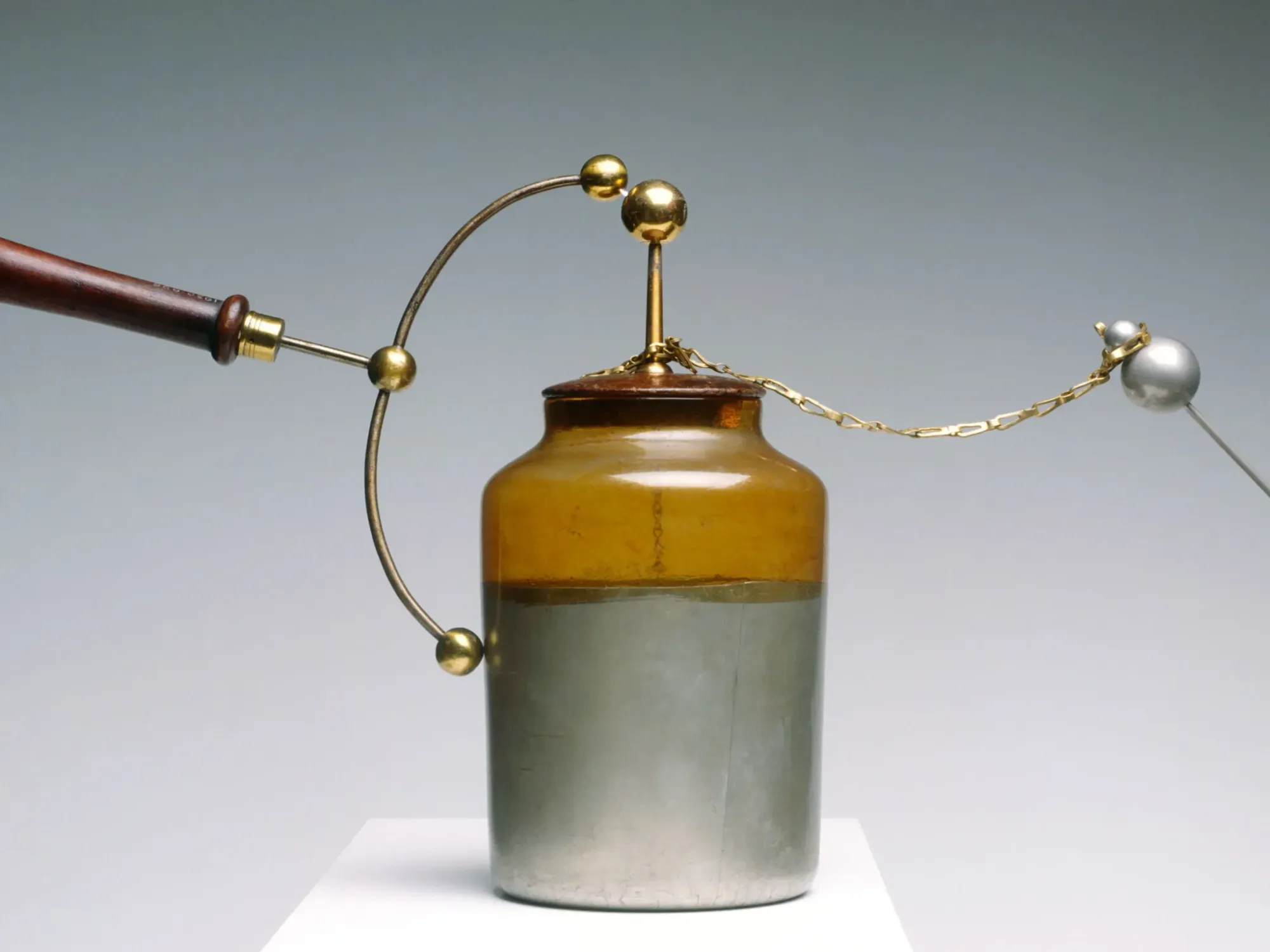
Control Yourself
Give a company a little room to disappoint you in the short-term and a lot of room to exceed your expectations in the long-term.
The great thing about microcaps is they can 2-3-5-10x and still be small companies/a new idea to someone else.

In 1746, Pieter van Musschenbroek invented the Leyden jar. It was a glass jar coated inside and out with metal foil that could hold and discharge electricity. Musschenbroek discovered it could produce and store a high-voltage electric charge. It was the first iteration of the modern-day capacitor. News of the Leyden jar spread rapidly among scientists.

Benjamin Franklin learned about it and obtained one of the jars to experiment with in Philadelphia. Franklin theorized that the Leyden jar’s inner and outer foils held positive and negative charges that attracted each other. When connected by a conductor, they discharged in a jolt of electricity. This was a seminal insight into the nature of opposingly charged particles.
In his famous kite experiment of 1752, Franklin flew a kite during a thunderstorm and used the Leyden jar to capture and store the electric charge from lightning, showing its connection to electricity. This proved his theory that lightning was an electrical phenomenon in the atmosphere.
The ability to capture lightning in a bottle lead to multiple discoveries and inventions around electricity. The image of capturing lightning, one of Earth’s most powerful phenomena, in a jar and holding it in your hands – it’s inspiring.
Many of the best investors ever started in microcaps. Many of the best performing stocks ever started as microcaps. Most of the best performing stocks over the last 10 years came out of the microcap ecosystem.
Great microcaps are lightning in bottle. They are the most powerful force in the public markets. All this power held within a tiny public company ready to be unleashed. The lightning is a small, unique, fundamentally robust business. The bottle is the constraints of a low outstanding share count.
Lightning in a Bottle Characteristics:
Why micro/small market caps?
Let’s not forget how small public companies are discovered: Smart retail -> Institutions -> Dumb retail. The smallest decile (sub-$100 million market cap) of the market isn’t owned by institutions. By default, small market caps are still in this first wave of discovery. They come out of nowhere to surprise institutions. Institutions are always attracted to fast growing profitable businesses they don’t own. Low to no institutional ownership is always best.
As I wrote in, An Essay on Investing in Small Stocks, “There are a bunch of small stocks that will 10x over the next five years that are waiting to be found. Institutions can’t buy them. Only you can. The opportunity in small stocks (microcaps) exists because institutions can’t own them until they go up. It is the small retail investor’s duty to find them and collect the reward for doing so.”
As management executes the business accelerates. The expectations and fundamentals drive the stock price up. As the stock goes up the liquidity increases allowing institutions to take a position. First smaller institutions. Then larger institutions and indices start buying. Lightning strikes. I wrote this 9 years ago, but it still holds true, “Don’t worry about illiquidity, worry about being right.”
The great thing about small market caps is they can 2-3-5-10x and still be small companies/a new idea to someone else.
Why is high organic growth and/or operating leverage important?
I love organic growth and high operating leverage. The higher the better as long as the business is profitable or has a cash runway to massive EPS growth. Why is organic growth important? If you are paying a fair price (at or below historical multiples), and the company isn’t diluting, the long-term forward returns should match the organic growth rate. Lower organic revenue growth can also be explosive if it’s a high operating leverage business. Operating leverage is when a small percentage increase in sales can lead to a large percentage increase in operating profit. The most explosive ideas have both organic growth and high operating leverage. They are rare.
Why is a small outstanding share count important?
First, scarcity is the most powerful driver of price. Great businesses in microcap are scarce. Illiquidity is the scarcity of shares. It’s the combination of these two forms of scarcity that are powerful. Less shares outstanding means less turnover (on average) to increase the share price. Put simply, there are fewer total shares available to buy. Illiquidity is very powerful when it’s combined with a great business. Why? Investors are forced to pay up to own shares.
Pablo Picasso only painted 1,900 original works. Most of these are held by private collectors or museums that are never selling. Only a small fraction of original works are available for sale each year. His paintings are always in high demand by the world’s elite. They are status symbols. When one or two come up for sale each year they sell for tens of millions to over a hundred million dollars. Scarcity.
Here is the second reason a low outstanding share count is important. Let’s compare two companies:
You might be thinking, “Now Ian they are both earning $10 million, it shouldn’t matter.” But it does. Company A will be a $10+ stock. Company B will be a $1+ stock. Some institutions aren’t allowed to buy Penny Stocks which most define as a stock less than $5.00 per share. When you are a $10+ you are automatically on the radars of larger pools of capital.
Here is the third reason a low outstanding share count is important. Investors are generally more attracted to companies that can make larger, more visible, EPS increases. A business that can rapidly grow EPS from $0.00 to $1.00 to $2.00 over a 12–36-month period creates 10-baggers. It’s the optically large EPS numbers, driven by a low share count, combined with it growing quickly that creates a euphoria of interest that excites the crowd. Investor’s minds wander as to the upper limits of the earnings power. The PE moves from undervalued to fairly valued to overvalued and priced for perfection. The move can be explosive. EPS goes from $0.20 to $2.00 while the PE goes from 12 to 50 in a few years. This is lightning in a bottle.
A word of caution. These are small businesses. You want to constantly ask yourself – Is the current EPS sustainable let alone the growth trajectory sustainable? In most cases the explosive rise in EPS is driven by one or two products taking off over a period of time, or one or two partners making large purchases, or perhaps the company is taking advantage of the system (ex. high healthcare reimbursement), or cyclical buying patterns, or covid pull forwards of demand etc. We all want to find sustainable EPS growers, but there is nothing wrong with riding a wave. Your job is to seek the truth and stay in reality. If you know the current EPS trajectory has a short shelf life, then take profits before the wave hits the shore. Everyone likes high organic growth, but I like figuring out the broader trends because nobody ever takes the time to verify if organic growth is sustainable – they just extrapolate upwards until a bad quarter forces them to extrapolate downwards and that’s how you lose money.
Second word of caution. When you find lightning in a bottle and the stock goes up 3-5-10x in a short period of time – the stock eventually becomes priced for perfection. When this occurs, there is a 90% chance the business will have an upcoming quarter where it stubs its toe and misses expectations. The stock will fall 50-70% from highs as the lightning dissipates as the multiple contracts. The investor base turns over. Traders, momentum algos, and all short-term investors leave. The cultish long-term investors are the only bid support. It takes quarters, years, maybe never for the fundamentals to backfill into a valuation where an upward move is reinitiated, and new highs can be made. This is where balancing conviction and being opportunistic comes into play. How much if any should you sell on the rise? This can only be answered by you.
Nonetheless, the goal is to find lightning in a bottle. The goal is to find XPEL early or [insert symbol of any of the top performers in our company performance] that shows sustainable operating performance. The key is to find a small business that has the right product, people, processes, and culture to scale up and out of the microcap ecosystem.
===> Interact and learn with 250+ of the best microcap investors on the planet. [Join Us]
MicroCapClub is an exclusive forum for experienced microcap investors focused on microcap companies (sub $500m market cap) trading on United States, Canadian, European, and Australian markets. MicroCapClub was created to be a platform for experienced microcap investors to share and discuss stock ideas. Since 2011, our members have profiled 900+ microcap companies. Investors can join our community by applying to become a member or subscribing to gain instant view only access. MicroCapClub’s mission is to foster the highest quality microcap investor Community, produce Educational content for investors, and promote better Leadership in the microcap arena. For more information, visit http://microcapclub.com and https://microcapclub.com/summit/
Get Alerted to our Next Educational Blog Post

Give a company a little room to disappoint you in the short-term and a lot of room to exceed your expectations in the long-term.

My intention is to hold stocks forever, but the harsh reality is every stock has different shelf life.

How does a business get a premium valuation when they sell a commodity?